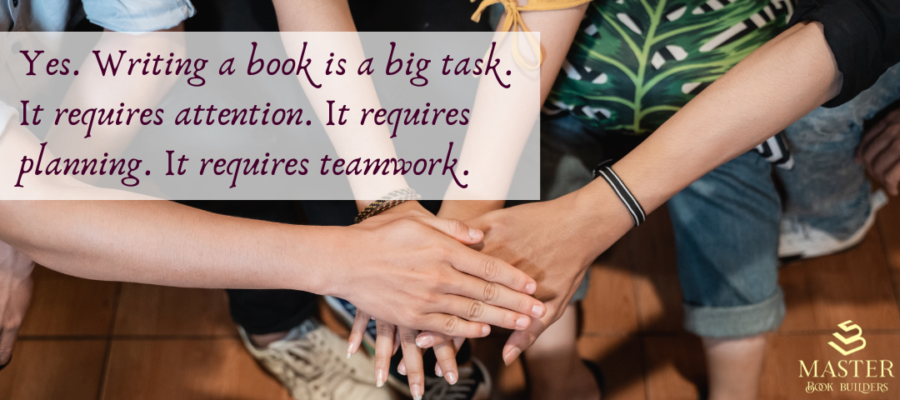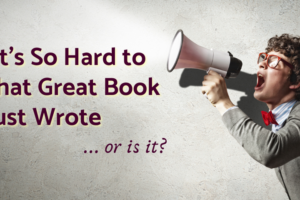Writing a book for beginners – Is Becoming an Author in Your Future for 2024?
I’ve met more people at live networking events or on LinkedIn or in digital Zoom events who all say,
“I’ve always wanted to write a book.”
But they haven’t. They’ve procrastinated and put it off for so long, most of them have decided to just give up on the idea completely. Because they think writing a book is hard.
Is it hard?
Yes. It’s a big task. It requires attention. It requires planning. It requires teamwork.
Let’s talk about all of that today. I’ll give you a little beginner’s lesson in how to get started on that book because I know you want to. I know you don’t want to be like all those people I meet who just talk about writing a book and never do anything about it.
Let me sigh. I sigh because it disappoints me that so many would-be authors will miss out on the advantages of becoming “the author of” merely because they can’t figure out how to get started.
How to write a book for beginners – your team
✨ The first person on your team should be your book coach. Sometimes, as it is at Master Book Builders, your book coach is also your developmental editor.
I fulfill both of those roles for my authors. As a book coach, I make sure we have a plan and that we stick to the plan. I support my authors as they write their book – through writer’s block, through those moments of doubt about what they’re doing, and through the scary tasks of marketing.
🌟 Yes, you must do your own marketing. You must be your own cheerleader. I wrote a recent blog post about a book being the best marketing tool you can have in your marketing tool box. Referencing the idea of writing and publishing your book I assure you:
(click the link to see the complete post “The Mightiest Marketing Tool in Any Business Toolbox”)
✨ The second person on your team should be your proofreader. Again, sometimes this is done in-house, as it is at MBB. We have a number of people who go over each manuscript to correct errors and get it polished to excellence. You must never think you can be your own editor or proofreader.
✨ Now, you need an experienced book cover designer. Not all designers can create an appealing book cover. Tom is our in-house book cover designer. His secret sauce is that he reads the book to determine what the cover should look like. And, of course, it’s back and forth with the author. We don’t dictate design. We guide and mentor because sometimes that color or specific font just isn’t right. I prefer author’s pictures on the cover, but that’s a personal choice, of course.
✨ Your next team member is your interior designer. This person creates the interior design of the book not your house! 😅 They create the running headers and decide where to put the page numbers. They help you choose the right font, and decide how chapter titles should look. It’s not merely words on a page. It’s design. All in collaboration with you, the author, of course. Once again, MBB does this in-house. Tom is our go-to guy for all things page design.
✨ It’s helpful to work with someone who knows publishing. You don’t need to decide how you want to publish upfront. Some people come to us with dreams of becoming the next Tony Robbins or Jack Canfield. They have stars in their eyes, and I gently bring them down to earth because the world of publishing has changed dramatically in the 21st century. The Big 5 Publishing houses are incredibly hard to get into today.
I know your book idea has possibilities. Indeed, dreaming of becoming a bestseller is not a bad thing. But the traditional publishing world requires massive followings on social and there is the time constrainst. Do you want your book published now or later? Your best bet is to find an agent. Which can literally take months. With no guarantee the agent will get you in front of an editor at one of the Big 5. Can you hear the clock ticking?
Is that time well spent?
Plus, you, the author, will be in charge of marketing, promotions, and sales. #TRUTH
That’s why we prefer Indie Publishing. Where you become your own publishing company. With our guidance.
Of course, if you truly desire a publishing company, we can recommend some small presses. Do understand that even then, you are in charge of marketing and promotions. With little help from your publisher. It’s something we’ve seen over and over.
If you want to discuss your options, we are happy to help. Just DM me on LinkedIn.
✨ You absolutely want someone who knows Amazon. I know you may want to sell your book on your website. We can help with that. I know you’ve heard horror stories about Amazon, but Amazon is the biggest retailer on the planet, at least for books. It’s in your best interests to be on that platform. And you want someone who knows how to get you there successfully. ***yes, we do Amazon best seller programs; most people do these days but understand that becoming an Amazon bestseller is just one part of your marketing; don’t rely on it to sell enough books to buy your next car.***

How to write a book for beginners – your content
With your team in place, you can begin writing your book.
But first, where is the content coming from? Your head? Your heart? Or your computer?
Many authors start from scratch. They create their TOC – otherwise known as the Table of Contents, a fluid, changeable document until the very day you decide to send your manuscript off for a print proof – and begin from there.
Other writers choose to write until their muse inspires them. Or is it wait until their muse inspires them? I believe it’s wait and, in that case, you may move on. Because if you’re waiting for your muse to inspire you, you’ll be waiting a long time.
Loryn Cole, on Copyblogger, puts it this way,
Your muse is a flaky friend who promises to hang out but never calls. Your muse is a boss who promises a raise but never gives you a review.
Forget the muse. She’s only invited if she can be consistent in supporting you as you write.
If you’re writing from word one, you have a big task in front of you. The better to be working with a developmental editor.
An alternative approach is to look at content on your computer. This might be in articles you’ve written elsewhere or for your own blog. It could be in LinkedIn posts. It could even include content posted on Instagram or other social channels.
Gather together as much content as you can from all of these sources and create your book. Choose articles that have similar content and meaning. Pull them together into chapters. Put aside the content that isn’t a good fit for this book. It may work for a book later on.
Think, as you do this, of your Throughline. We’ve discussed Throughlines before. Just about a year ago, Tom wrote a post about this: “Throughline: The ‘Wiring Diagram’ for Building Your Book.”
He says,
Take a few minutes to think about the core idea for your book. Think about your message and how you might describe the cord that connects all its elements.
That’s your Throughline and your content should have one, from article to article and chapter to chapter.
Now begin.
What else do you need to know about writing that first book?
I’ll leave you with these thoughts – you should have a dedicated place to write. A place you will not be disturbed. Preferably a place with a door. Close the door.
Write at the best time of day for you. For me, it’s morning. Between 7 -11 I’m my most prolific. After that, I need to turn my thoughts to my work with clients. I am no good after 4:00 for writing anything original.
Try and set a word count. It could be 500 words a day to start. Then, 1000 words as you get better at it. Maybe you can start out with 1000 words and creep up to 1500 words. It’s your choice. Write at a pace that is easy for you. Don’t let anyone tell you how many words a day you should write. You are in charge of you and of your book.
The important thing is to just get started!
If your current busy schedule is preventing you from writing your book, maybe you should speak it into existence. Then have it transcribed and sent to your book coach/developmental editor to work on.
There is always a way.
Books don’t have to be written in six weeks, or three months. They can take a year or a year and a half. Rushing a project does not make for the best results.
And, last but not least, identify your readers. We’ll talk more about this in another blog post but for now, you must put your readers first as you write! The book is not about you or for you, as much as it’s about them and for them.
If you need more advice or just want to chat about your book idea, let’s do a 20-minute call. It’s on the house. More than 20 minutes does incur a cost, but it’s nominal. So don’t hesitate to ask.
You have questions. I have answers. It’s as easy as that.



![featured image for blog post, [TfTi] Ya Think?!? 'Self-Publishing's Output and Influence Continue to Grow' by Tom Collins](https://masterbookbuilders.com/wp-content/uploads/2024/11/IndieAuthorInfluenceGrowing-300x200.jpg)


1 Comment
Leave your reply.